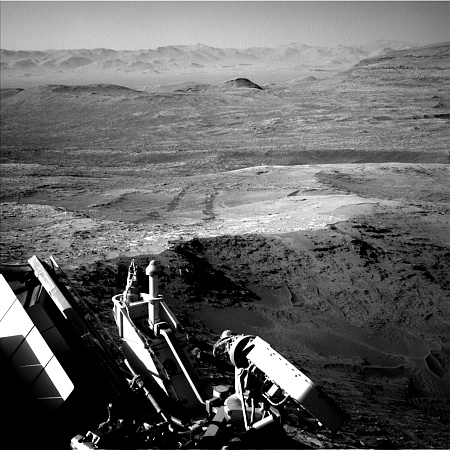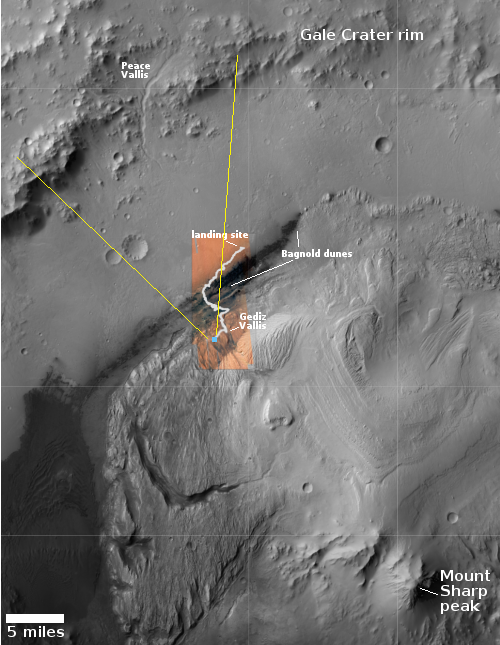Curiosity looks back
Cool image time! The picture to the right, reduced and enhanced to post here, was taken on July 28, 2025 by the left navigation camera on the Mars rover Curiosity. It looks to the north, down the flanks of Mount Sharp and across the floor of Gale Crater to its mountainous rim about 30 miles way, seen on the horizon.
The view is so clear because of the season, as noted in the science team’s blog post today:
We’re still in the time of year where the atmosphere at Gale is reasonably dust-free (at least, compared to later in the year), allowing us to look all the way out to and beyond the Gale crater rim. The upper slopes of Mount Sharp have also re-emerged to our east after spending months hidden behind the walls of Gediz Vallis. There’s a bit more sand and dust in this location than we’ve seen recently, so we can also see the trail left behind by the rover’s wheels as we drove to this location
The ridge in the foreground is an example of the boxwork Curiosity is presently traversing. It is now on one of those ridges, and will be moving along it in short drives as the science team studies the geology here. The rover’s tracks leading up to this position can be seen clearly.
The overview map to the right gives the larger context within Gale Crater. The white line marks Curiosity’s travels since it landed in 2012. The blue dot marks its present position, with the yellow lines indicating the approximate area viewed by the above picture.
This map provides an overall snapshot of Curiosity entire journey so far in Gale Crater. It has traveled just over 22 miles in the last thirteen years, climbing about 2,600 feet from the crater floor. To get to the peak of Mount Sharp however will require another 25 miles of travel climbing another 16,000 feet.
Thus, though Curiosity has provided us some spectacular views of the most dramatic landscape so far explored on another world, it really has only covered a tiny portion of Mars. The land surface of the Red Planet is actually comparable to that of Earth, since Mars has no oceans. The rovers have barely seen three dozen miles of terrain, and have taken decades to do so.
If we really want to explore Mars, we really have no choice but to go their ourselves. Robotic rovers or even robotic helicopters will only give us a narrow glimpse. We need feet on the ground to truly see this place, as it is.
On Christmas Eve 1968 three Americans became the first humans to visit another world. What they did to celebrate was unexpected and profound, and will be remembered throughout all human history. Genesis: the Story of Apollo 8, Robert Zimmerman's classic history of humanity's first journey to another world, tells that story, and it is now available as both an ebook and an audiobook, both with a foreword by Valerie Anders and a new introduction by Robert Zimmerman.
The print edition can be purchased at Amazon or from any other book seller. If you want an autographed copy the price is $60 for the hardback and $45 for the paperback, plus $8 shipping for each. Go here for purchasing details. The ebook is available everywhere for $5.99 (before discount) at amazon, or direct from my ebook publisher, ebookit. If you buy it from ebookit you don't support the big tech companies and the author gets a bigger cut much sooner.
The audiobook is also available at all these vendors, and is also free with a 30-day trial membership to Audible.
"Not simply about one mission, [Genesis] is also the history of America's quest for the moon... Zimmerman has done a masterful job of tying disparate events together into a solid account of one of America's greatest human triumphs."--San Antonio Express-News
Cool image time! The picture to the right, reduced and enhanced to post here, was taken on July 28, 2025 by the left navigation camera on the Mars rover Curiosity. It looks to the north, down the flanks of Mount Sharp and across the floor of Gale Crater to its mountainous rim about 30 miles way, seen on the horizon.
The view is so clear because of the season, as noted in the science team’s blog post today:
We’re still in the time of year where the atmosphere at Gale is reasonably dust-free (at least, compared to later in the year), allowing us to look all the way out to and beyond the Gale crater rim. The upper slopes of Mount Sharp have also re-emerged to our east after spending months hidden behind the walls of Gediz Vallis. There’s a bit more sand and dust in this location than we’ve seen recently, so we can also see the trail left behind by the rover’s wheels as we drove to this location
The ridge in the foreground is an example of the boxwork Curiosity is presently traversing. It is now on one of those ridges, and will be moving along it in short drives as the science team studies the geology here. The rover’s tracks leading up to this position can be seen clearly.
The overview map to the right gives the larger context within Gale Crater. The white line marks Curiosity’s travels since it landed in 2012. The blue dot marks its present position, with the yellow lines indicating the approximate area viewed by the above picture.
This map provides an overall snapshot of Curiosity entire journey so far in Gale Crater. It has traveled just over 22 miles in the last thirteen years, climbing about 2,600 feet from the crater floor. To get to the peak of Mount Sharp however will require another 25 miles of travel climbing another 16,000 feet.
Thus, though Curiosity has provided us some spectacular views of the most dramatic landscape so far explored on another world, it really has only covered a tiny portion of Mars. The land surface of the Red Planet is actually comparable to that of Earth, since Mars has no oceans. The rovers have barely seen three dozen miles of terrain, and have taken decades to do so.
If we really want to explore Mars, we really have no choice but to go their ourselves. Robotic rovers or even robotic helicopters will only give us a narrow glimpse. We need feet on the ground to truly see this place, as it is.
On Christmas Eve 1968 three Americans became the first humans to visit another world. What they did to celebrate was unexpected and profound, and will be remembered throughout all human history. Genesis: the Story of Apollo 8, Robert Zimmerman's classic history of humanity's first journey to another world, tells that story, and it is now available as both an ebook and an audiobook, both with a foreword by Valerie Anders and a new introduction by Robert Zimmerman.
The print edition can be purchased at Amazon or from any other book seller. If you want an autographed copy the price is $60 for the hardback and $45 for the paperback, plus $8 shipping for each. Go here for purchasing details. The ebook is available everywhere for $5.99 (before discount) at amazon, or direct from my ebook publisher, ebookit. If you buy it from ebookit you don't support the big tech companies and the author gets a bigger cut much sooner.
The audiobook is also available at all these vendors, and is also free with a 30-day trial membership to Audible.
"Not simply about one mission, [Genesis] is also the history of America's quest for the moon... Zimmerman has done a masterful job of tying disparate events together into a solid account of one of America's greatest human triumphs."--San Antonio Express-News




It is inspiring and very cool to see man-made tracks on Mars.